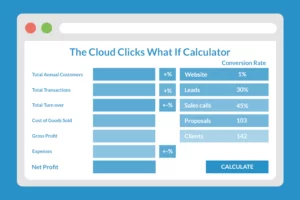Why Pay-Per-Click is a Must-Have for ecommerce business website advertising? In today’s competitive online marketplace, businesses need every advantage they can get to stand out and attract potential customers. PPC advertising is an effective way to gain a competitive edge in the online marketplace and make e-commerce websites stand out.
In this blog post, we will explore the various aspects of PPC marketing that make it essential for e-commerce business websites. We’ll start by discussing what PPC is, its benefits, and the different types of PPC ad platforms.
Next, we’ll delve into setting up a successful PPC campaign by choosing the right platforms, budgeting strategies, and creating ads and landing pages that convert visitors into buyers. Additionally, we will discuss optimizing your campaigns for maximum return on investment (ROI).
Furthermore, we’ll share proven strategies for effective PPC management including keyword research targeting techniques and ad copywriting tips,along with A/B testing methods
We will also cover common mistakes to avoid such as not conducting proper keyword searching or neglecting landing page optimization.
Last but not least; We’ll guide you through tracking key performance metrics like conversion rates and cost per acquisition (CPA), click-through rates (CTR), quality scores, and monitoring impression shares to help you achieve optimal results from your ecommerce PPC efforts.
1. What is pay per click (PPC)advertising strategy?
Pay per click (PPC) is a form of paid search management in digital marketing that enables businesses to promote their ads on various online platforms and only pay an ad network when users click better than an ad space and email marketing.

The ad clicks will make it an economical way for e-commerce websites to reach out to their target audience, drive traffic, and increase sales. In this section, we will explore the definition of a PPC ad campaign, its benefits for e-commerce websites, and different types of PPC ads.
a. Definition of PPC
It refers to an online paid search management where a business pays an ad network each time one of their advertisements is clicked by a user. Essentially, PPC is a method of buying visits to a website rather than trying to acquire them naturally through SEO. PPC advertising, most commonly found on search engines such as Google Ads and Bing Ads, provides a way for businesses to buy visits to their website.
b. Benefits of PPC
E-commerce websites can greatly benefit from incorporating PPC advertisements into their marketing strategies and the first ad due to several reasons:
- Increase brand visibility: With targeted ad placements in front of prospective customers who are actively searching for products or services similar to yours, you’ll boost your brand awareness quickly.
- Faster results compared to SEO: While organic SEO efforts take time before yielding significant results, with well-executed PPC ads you can see immediate increases in traffic and conversions.
- Budget control: You have complete control over how much you spend per click as well as daily budgets which makes it easy for businesses with varying marketing budget sizes.
- Data-driven decisions: Detailed analytics provided by PPC platforms enable you to make informed decisions about your marketing strategies and optimize campaigns for better results.
c. Types of PPC Ads
There are several types of PPC ads that e-commerce websites can utilize, depending on their specific goals and target audience:
- Search Ads: These ads appear at the top or bottom of search engine results pages (SERPs) when users search for specific keywords related to your products or services. Learn more about search engine marketing here.
- Display Ads: Display ads are visual advertisements ( images, videos, or text) placed on third-party websites within a network like Google’s Display Network.
- Social Media Ads: Platforms such as Facebook, Instagram, LinkedIn, and Twitter offer advertising options. Discover how to create effective social media ads with this comprehensive guide by Hootsuite: “Social Media Advertising 101: How to Get the Most Out of Your Ad Budget“.
2. How to Set Up a PPC Campaign?
Creating a triumphant PPC effort for your online store necessitates various critical actions. In this section, we will guide you through each step of the process.

a. Choosing the Right Platforms
The first step in setting up PPC ads is selecting the appropriate advertising strategy, ad groups, and paid search management that is aligned with your target consumers and business goals. Some popular choices include Google Ads, Microsoft Advertising (formerly Bing Ads), and social media platforms like Facebook Ads or LinkedIn Ads. Research each paid search platform’s features, targeting options, and ad formats to determine which social media marketing best suits your needs.
b. Setting Up Your Budget and Bidding Strategy
Next, establish a budget for your PPC ads by determining how much you’re willing to spend on advertisements daily or monthly. Once you have set a budget, choose an appropriate bidding strategy based on factors such as competition level and desired ad position:
- CPC (Cost Per Click): You pay only when a customer clicks on your ad.
- CPM (Cost Per Thousand Impressions): You purchase per thousand views of your ad regardless of whether users click it or not.
- CPA (Cost Per Acquisition): You pay only when a user completes a desired action, such as making a purchase or signing up for your newsletter.
c. Creating Ads and Landing Pages
The third step is to create compelling advertisements. Focus on writing clear, concise ad copy with strong calls-to-action (CTAs) that encourage users to click through to your website. Additionally, ensure that your landing pages are optimized for conversions by:
- Maintaining consistency between ad messaging and landing page content.
- Including persuasive headlines and engaging visuals.
- Supplying straightforward navigational choices so customers can rapidly access the information they seek.
- Using trust signals like customer reviews or security badges to build credibility with visitors.
d. Optimizing Your Campaigns for Maximum ROI
To get the most out of your PPC marketing, continuous optimization is crucial. Monitor performance metrics regularly using tools like Google Analytics or Facebook Insights to identify areas where improvements can be made.
Some optimization tactics include adjusting bids based on keyword performance, testing different ad variations (A/B testing), refining targeting settings, and adding negative keywords to exclude irrelevant traffic sources from seeing your advertisements.
3. Strategies for Effective PPC Management
By utilizing the strategies discussed in this section, you can maximize your ROI for an e-commerce website and ensure that your advertisements reach the right audience at the right time to drive conversions.

a. Keyword Research and Targeting Strategies
Identifying terms that customers may employ when looking for goods or services comparable to yours is an important part of any successful PPC effort and SEO attributes. To conduct keyword searching, you can use tools like Google Ads Keyword Planner, SEMrush, or Ahrefs Keywords Explorer.
- Long-tail keywords: Focus on long-tail keywords as they have lower competition and higher conversion rates compared to broad terms.
- Negative keywords: Exclude irrelevant search terms by adding negative keywords to prevent wasting budget on clicks from users who aren’t interested in your offerings.
- Geo-targeting: If applicable, narrow down your targeting based on geographic location to show advertisements only to users within specific regions where your products or services are available.
b. Ad Copywriting Tips
Here are some tips for writing compelling ad copy:
- Include your target keyword: Make sure to include the primary keyword in the ad headline and description to improve relevancy and increase click-through rates (CTR).
- Create a strong call-to-action (CTA): Use clear, actionable language that encourages users to take immediate action, such as “Buy Now,” “Shop Today,” or “Get Started.”
- Highlight unique selling points (USPs): Mention any special offers, discounts, or features that set your products apart from competitors.
- A/B test different variations: Test multiple ad copy variations simultaneously to determine which one performs best and optimize accordingly.
c. A/B Testing Strategies
A/B testing is an essential strategy for optimizing PPC campaign by comparing two or more versions of advertisements, landing pages, or other campaign elements against each other. This helps you identify which version generates better results in terms of CTRs, conversion rates, and overall ROI. Here are some key aspects to consider when conducting A/B tests:
- Select a single variable at a time: To ensure accurate results from your tests, only change one element per test while keeping everything else constant.
- Use Google Ads Experiments tool: This built-in feature allows you to create split tests within your Google Ads account easily.
Having a good understanding of the strategies for effective PPC management is essential to achieving success with pay-per-click marketing. Knowing the usual errors with ecommerce PPC campaigns is essential for preventing expensive mistakes.
4. Common Mistakes to Avoid in PPC Advertising
To ensure your ecommerce PPC advertising is successful, it’s important to be aware of the common errors that can occur. To ensure your PPC campaigns are successful, take note of the following mistakes below.

a. Not Doing Proper Keyword Research
It is an essential aspect of any PPC campaign, as it helps you identify the most relevant and high-converting keywords for your target audience. Failing to conduct thorough keyword exploration can lead to wasted ad spending on irrelevant or low-performing keywords.
To avoid this mistake, use tools like Google Ads Keyword Planner, SEMrush, or Ahrefs Keywords Explorer to find profitable right keywords with good search volume and low competition.
b. Not Optimizing Landing Page for Conversions
Once visitors click on your advertisement, the landing page is a critical element in conversion rates. A poorly designed or unoptimized landing page can result in high bounce rates and low conversion rates, wasting valuable ad spend. Ensure that your landing pages are optimized by following these best practices:
- Create clear and compelling headlines that match the messaging in your advertisements.
- Incorporate strong calls-to-action (CTAs) throughout the page.
- A/B test different elements such as images, copy, layout, etc., to improve conversions over time.
- Ensure fast loading times by optimizing images and using a PageSpeed Insights tool to identify areas for improvement.
- Make your landing page mobile-friendly to accommodate the majority of users.
c. Not Tracking Performance Metrics
To maximize the efficiency of your ecommerce PPC, tracking key performance metrics such as CTRs, conversion rates, CPA and ROAS is essential for evaluating success and refining strategies. Use platforms like Google Analytics or other third-party tools to monitor these important KPIs regularly so you can make data-driven decisions about how to improve your campaign performance over time.
It is essential to recognize and avoid common mistakes in ecommerce PPC so that you can maximize the effectiveness of your campaigns. Moving on, it’s also important to measure success by tracking conversion rates, cost per acquisition (CPA), click-through rates (CTR), and quality scores as well as monitoring impression share.
5. Measuring the Success of Your PPC Campaigns
In order to determine whether your PPC campaigns are successful, it’s essential to measure their performance using revenue tracking.

a. Tracking Conversion Rates and Cost Per Acquisition (CPA)
Measuring the success of an e-commerce campaign, conversion metrics are determined by calculating the ratio of users who completed a desired action (e.g., making a purchase or signing up for a newsletter) to total clicks on advertisements. To calculate the conversion rate, divide the number of conversions by the total number of clicks on your ads:
The cost per acquisition (CPA), on the other hand, refers to how much it costs you to acquire each new customer through your ecommerce PPC. It’s calculated by dividing total ad spend by the number of conversions:
A lower CPA indicates that your campaign is more efficient at driving sales while keeping costs down.
b. Analyzing Click-Through Rates (CTR) and Quality Scores
The click-through rate (CTR) is the percentage of users who clicked on your ad after seeing it. A higher CTR indicates that your ads are relevant and engaging to users, leading them to click through and visit your ecommerce websites:
In addition to CTR, Quality Score is another important metric provided by Google Adwords. It’s a measure of the degree to which your keywords, advertisements, and landing pages align with what users are seeking online and on the search engine. A high-quality score can lead to lower costs per click (CPC) and better ad positions.
c. Monitoring Impression Share
Impression share shows you how often prospective customers see your ads when searching for relevant products or services:
A low impression share may indicate that there’s room for improvement in terms of increasing visibility or adjusting bidding strategies.
Taking these metrics into account will help you understand if your ecommerce PPC are meeting their goals effectively while providing valuable insights into areas where adjustments can be made.
Frequently Asked Questions
Conclusion
Pay-per-click advertising is an essential tool for e-commerce websites looking to increase their visibility and reach more potential customers. With the right strategies in place, commerce PPC can be incredibly effective for ecommerce businesses at driving targeted traffic to your website and generating leads or sales of your ready to buy shoppers on your online store.
Take advantage of the power of PPC advertising to increase your e-commerce website’s visibility and increase revenue. With our comprehensive solutions, you can maximize ROI while staying ahead of the competition.







